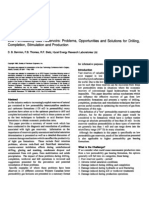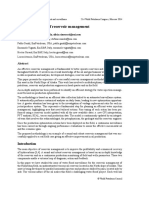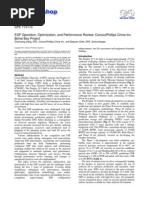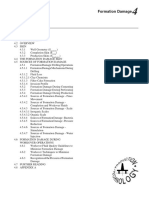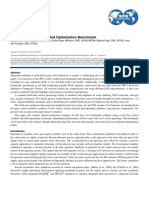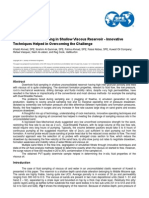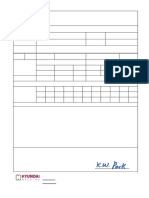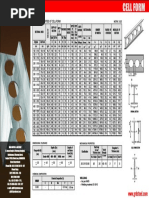SPE 117366 Hydrochloric Acid Fracturing Combined With Water Shut-Off
SPE 117366 Hydrochloric Acid Fracturing Combined With Water Shut-Off
Uploaded by
amramazon88Copyright:
Available Formats
SPE 117366 Hydrochloric Acid Fracturing Combined With Water Shut-Off
SPE 117366 Hydrochloric Acid Fracturing Combined With Water Shut-Off
Uploaded by
amramazon88Original Title
Copyright
Available Formats
Share this document
Did you find this document useful?
Is this content inappropriate?
Copyright:
Available Formats
SPE 117366 Hydrochloric Acid Fracturing Combined With Water Shut-Off
SPE 117366 Hydrochloric Acid Fracturing Combined With Water Shut-Off
Uploaded by
amramazon88Copyright:
Available Formats
SPE 117366
Hydrochloric Acid Fracturing Combined with Water Shut-Off
L.A.Magadova, M.A.Silin, V.B.Gubanov, V.N.Marinenko, V.R.Magadov (Russian State University of Oil and Gas
named after I.M. Gubkin, N.A.Demianenko (BelNIPIneft, RUE Production Association Belorusneft)
Copyright 2008, Society of Petroleum Engineers
This paper was prepared for presentation at the 2008 SPE Russian Oil & Gas Technical Conference and Exhibition held in Moscow, Russia, 2830 October 2008.
This paper was selected for presentation by an SPE program committee following review of information contained in an abstract submitted by the author(s). Contents of the paper have not
been reviewed by the Society of Petroleum Engineers and are subject to correction by the author(s). The material does not necessarily reflect any position of the Society of Petroleum
Engineers, its officers, or members. Electronic reproduction, distribution, or storage of any part of this paper without the written consent of the Society of Petroleum Engineers is prohibited.
Permission to reproduce in print is restricted to an abstract of not more than 300 words; illustrations may not be copied. The abstract must contain conspicuous acknowledgment of SPE
copyright.
Institute of oilfield chemistry under Russian State University of oil and gas named after
I.M. Gubkin in cooperation with BelNIPIneft, RUE Production Association
Belorusneft have developed the technology of formation hydrochloric acid hydraulic
fracturing combined with water shut-off in producing wells, exposing carbonate reservoirs.
It is known that during interaction of hydrochloric acid solutions and oil, containing big
quantity of tars and asphaltenes sludging and formation of emulsions colmataging porous space
of reservoir take place.
In our work we have used the ability of generating such compounds when hydrochloric
acid contacts hydrocarbon gel, composed using gelling complex Khimeco-H based on ferric
salts of organic orthophosphoric ethers and stock (commercial) oil.
Hydrocarbon gels based on ferric salts of organic orthophosphoric ethers are obtained by
dissoluting in hydrocarbon fluids gelling agent (mixture of alkylphosphoric ethers, mainly
diakylphosphoric ethers) and activator based on ferrous compounds. As a result of interaction
between gelling agent and activator we ontain ferric salts of organic orthophosphoric ethers
which in their turn create associated complexes of molecular weight in hydrocarbons.
Associated complexes explain formation of hydrocarbon gel used in hydraulic fracturing.
Below you see the mechanism of hydrocarbon gel formation:
1. Gelling agent +activator = ferric salts of organic orthophosphoric ethers:
O
||
[R1O - P - O]b(OH)a , where: a= 0-2;
|
b= 1-3;
a+b=3;
R2O
where R1, R2 different hydrocarbon radicals, in the capacity of one of them could be
hydrogen;
ferrum atom.
2. Formation of associated complex while dissoluting the salts obtained (figure 1):
SPE 117366
Fig.1 Formation of associated complex while dissoluting the salts of
organic orthophosphoric ethers
As a result of interaction of hydrocarbon gel and hydrochloric acid and generation of
controlled quantity of asphaltene and tar sediments/sludges we form the layer, having selective
shutting-off impact on watersaturated interlayers.
For checking planned result we carried out filtration experiments on high-pressure and
temperature plant HP-CFS in the formation process simulation laboratory of the Institute of
oilfield chemistry under Russian State University of oil and gas named after I.M. Gubkin.
Schematic diagram of experimental plant HP-CFS is shown on figure 2.
Plant HP-CFS makes possible carrying out filtrarion experiments on sand packed tubes
of porous mediums and core samples under temperatures up to 150C and pressure up to 20,0
MPa. If necessary back pressure system, which provides maximum level of pressure 7,0 MPa
can be used. While working with core samples squeezing pressure can reach 50,0 MPa.
Main functional parts of the plant are thermostatically controlled filling formation model
and core holder for experimenting with core samples. Thereby depending on type of study its
possible to use core holder for composite cores 30 sm long (study of hydrodynamic parameters
of porous medium), or core holder for one core sample (study of compositions for acid
treatment, drilling muds, kill fluids).
Supply of operating fluids into porous medium is performed through press tubes with
separating pistons by fluid presses ISCO. From fluid presses ISCO oil is supplied into under
piston volume of press tubes. Thereby its possible to perform separate-simultaneous supply of
oil into each of press tubes, or just in one press tube with planned supply rate.
Filling the press tubes with operating fluids is carried out under vacuum after the
separating piston is in its lowermost position by gas pressure from the tank.
For injection of high-viscosity compositions, polymer or disperse systems into formation
model high pressure vessel is used. From the vessel reagent is supplied under gas pressure
from the tank or under immissible with reagent fluid from the press tube. During filtration
process pressure drops are being controlled by Gould differential manometer. Fluid filtration can
be performed under fixed flow rates up to 600 sm3/h.
Thermostating of filling model and preliminary heating of input line are performed by heat
tape winded around filling model body and input line. Heat tape is fed from the net 200V
SPE 117366
through autotransformer. The rate of temperature rise is provided by voltage control,
maintenance and control of temperature is provided by temperature sensor-controller -1,
connected to thermocouple, located on the model body.
Heating of the core sample inside the core holder to the temperature of the experiment is
provided by liquid thermostat.
During carried out filtration experiments we used hydrocarbon gel based on stock oil
(20 oil = 825 kg/m3), composition 1, also 12% and 24% inhibited hydrochloric acid with
addition of 4% of volume of multifunctional surface-active substance Neftenol (mark NK-FD),
formation water model of calcium chloride type, carbon oil and light gas oil.
Neftenol (mark NK-FD) is multifunctional surface-active substance based on
multicomponent mixture of anion and cation surface-active substances of different chemical
structure with modified polymer additives hydrochloric acid thickening agent, which is used as
an additive to hydrochloric acid while formation acid hydraulic fracturing.
Description of the experiments is given below (figures 3-4).
SPE 117366
Figure 2.
SPE 117366
Figure 2. Schematic diagram of experimental plant HP-CFS
1,2
3
4
5
6
7,8,9
10, 19
11,12
13
14
15
16
17
press tubes with separating pistons for reagent supply
fluid thermostate
formation model
back pressure system
heating element
high pressure press (IS)
vessels with oil for filling presses
gas tanks
core sampler
core holder
rubber collar
core sample
press for generation of squeezing pressure
SPE 117366
Experiment 1
Objective:
Estimation of acid treatment impact on gel cementing properties
Sample:
filling waters aturated model
filling
diameter
cross-section area
viscosity of
formation water under temperature 20
Initial model parameters:
model length
initial water permeability
porous volume
porosity
silica sand fraction
3,09
sm
7,50
sm2
1,301
MPas
62,4
18,11
163
34,8
sm
mkm2
sm3
%
Reagents under study:
1) gelling complex Khimeco-H-based hydrocarbon gel, composed on base of stock oil (20
oil = 825 kg/m3)
Volume of reagents, l/m3:
Gelling agent Khimeco-H 16,0
activator Khimeco-H18,0;
gel viscosity under temperature 20 = 68,83 MP.s under shear rate 656 s-1;
2) Carbon oil, viscosity under temperature 20 = 1,16 MP.s
3) Inhibited 12% hydrochloric acid with 4% of volume of multifunctional surface-active
substance Neftenol (mark NK-FD), viscosity under temperature 20 = 3,6 MP.s;
4) Formation water model, density 20 = 1,096 kg/m3, mineralization- 140 g/l, viscosity under
temperature 20 =1,301 MP.s.
Experimental stages:
1. Filtration through formation water model under room temperature. Determination of initial
permeability.
2. Gel injection under room temperature and different filtration rates.
3. Injection of 0,3 porous volume of 12% solution of iInhibited hydrochloric acid with addition of
4% of Neftenol (mark NK-FD) volume.
4. Injection of formation water under different filtration rates.
5. Conditioning under room temperature for 15 hours with further filtration of formation water
and determination of resistance factor R.
6. Injection in reverse direction of carbon oil to wash the model off asphalt-tarry paraffin
depositions and determination of resistance factor Rres.
7. Model conditioning for 2 days with further filtration of carbon oil and determination of final
resistance factor Rres.
SPE 117366
Experiment 2
Objective:
Estimation of acid treatment impact on gel cementing properties
Sample:
filling water saturated model
filling
diameter
cross-section area
viscosity of
formation water under temperature 20
Initial model parameters:
model length
initial water permeability
porous volume
porosity
silica sand fraction
3,09
sm
7,50
sm2
1,301
63,11
15,73
161,1
34,03
MPas
sm
mkm2
sm3
%
Reagents under study:
1) gelling complex Khimeco-H-based hydrocarbon gel, composed on base of stock oil (20
oil = 825 kg/m3)
Volume of reagents, l/m3:
Gelling agent Khimeco-H 16,0
activator Khimeco-H18,0;
gel viscosity under temperature 20 = 68,83 MP.s under shear rate 656 s-1;
2) Carbon oil, viscosity under temperature 20 = 1,16 MP.s
3) Inhibited 12% hydrochloric acid with 4% of volume of multifunctional surface-active
substance Neftenol (mark NK-FD), viscosity under temperature 20 = 3,6 MP.s;
4) Formation water model, density 20 = 1,096 kg/m3, mineralization- 140 g/l, viscosity under
temperature 20 =1,301 MP.s.
:
1. Filtration through formation water model under room temperature. Determination of initial
permeability.
2. Gel injection under room temperature and different filtration rates.
3. Injection of 0,3 porous volume of 12% solution of iInhibited hydrochloric acid with addition of
4% of Neftenol (mark NK-FD) volume.
4. Injection of formation water under different filtration rates.
5. Conditioning under room temperature 15 hours with further filtration of formation water and
determination of resistance factor R.
6. Injection in reverse direction of carbon oil to wash the model off asphalt-tarry paraffin
depositions and determination of resistance factor Rres.
SPE 117366
Studies showed, that while injecting gel decrease of permeability of porous medium
sample due to high viscosity of gel takes place, but even higher decrease of permeability takes
place during further acid injection due to sludging of asphalt-tarry paraffin depositions, whilst the
highest decrease is reached by using higher concentration of acid. So, while injecting 12% acid
residual resistance factor made up 17,63; and while injecting 24% acid residual resistance
factor made up 93,88. Necessary to mention that during first contact with acid resistance factor
grows much higher. Decrease of permeability due to sludging of asphalt-tarry paraffin
depositions takes place, and in case acid volume increases permeability increases, which is
explained possibly by the impact of surface-active substances in acid formulation while
formation water injection has practically no impact on resistance factor (see experiment 1,
fig.3).
Carbon oil injection in reverse direction with further conditioning significantly decreases
resistance factor to 5,74 and 9,39 for 12% and 24% acid respectively, and during light gasoil
injection-to 2,2 (experiment 2 fig.4).
For purity of experiment filtration studies were carried out using porous medium,
simulating the conditions of terrigenous reservoir for eliminating negative influence of carbonate
reservoir and hydrochloric acid interaction.
The idea of using hydrocarbon gel for hydrochloric acid fracturing with water shutt-off is
in formation of hydrocarbon-dissoluble sludges of asphaltenes and tars during interaction of
hydrocarbon gel and hydrochloric acid in the process of by-turn injection of hydrocarbon gel pill
and part of 12-24% hydrochloric acid, treated with 40 l/m3 of multifunctional surface-active
substance Neftenol K (mark NK-FD). This lets on one hand to create a fracture by formation
hydraulic fracturing and on the other hand selectively shut it off. Though, acid treated with
Neftenol K (mark NK-FD) in contact with pure oil doesnt sludge which is proved by carried
tests, shown in the table 1.
So, we purposefully shut-off big fractures where hydrocarbon gel comes to. Thereby
hydrocarbon sludges are dissoluted while diluting with oil, which shows selective water shut-off.
SPE 117366
Experiment 1
Experiment temperature 20 . Initial water permeability - 18,11 mkm2
FlR=80
3
sm /h
FlR=600
3
sm /h
10
FlR=400
3
sm /h
FlR=200
3
sm /h
FlR=300sm /h
FlR=600
3
sm /h
FlR=600
3
sm /h
FlR=200
3
sm /h
Rres =5,74
Conditioning
2 days
Rres=17,63
0,1
FlR=200
3
sm /h
Rres =1,00
Conditioning
15 hours
Form. water
injection
Permeability,
mkm2
FlR=600sm /h
100
Acid
injection
Form. water
injection
Gel injection
Carbon oil injection in reverse direction
0,01
0
10
15
20
25
30
35
40
Relative cumulative injection volume,Vinjec/Vpor
Fig. 3 Change in permeability of water saturated model after injection
of gel based on gelling complex "Khimeco -" and stock oil, and 12 % inhibited hydrochloric acid with addition
of Neftenol (mark NK -FD, 4% of volume ), formation water and carbon oil
Experiment 2
Experiment temperature 20 . Initial water permeability - 15,73 mkm2
100,0
Permeability, mkm
FlR=600
3
sm /h
FlR=400
3
sm /h
FlR=300 sm /h
FlR=80
3
sm /h
10,0
FlR=200
3
sm /h
FlR=200sm /h
Rres =7,11
FlR=200
3
sm /h
Rres =2,22
Rres =9,39
1,0
Acid
injection
Conditioning
15 hours
0,1
Rres =93,88
Formation water
injection
Carbon oil injection in
reverse direction
Gel injection
Light gasoil injection
0,0
0
10
12
14
16
Relative cumulative injection volume, Vinjec/Vpor
Fig. 4 Change in permeability of water saturated model after injection of gel based on gelling complex
"Khimeco- " and stock oil, and 24% inhibited hydrochloric acid
with addition of Neftenol K (mark NK-FD, 4% of volume ), formation water, carbon oil and light gasoil
10
SPE 117366
Table 1
Results of studies of interaction of acid compositions with stock oil
(20= 825 kg/m3) and formation water
1
1.
2.
3.
Studied fluid
2
Stock oil
20= 825 kg/m3
Stock oil
20= 825 kg/m3
Stock oil
20= 825 kg/m3
4.
Stock oil
20= 825 kg/m3
5.
Stock oil
20= 825 kg/m3
Stock oil
20= 825 kg/m3
Stock oil
20= 825 kg/m3
6.
7.
8.
Stock oil
20= 825 kg/m3
9.
Stock oil
20= 825 kg/m3+
formation water
Stock oil
20= 825 kg/m3+
formation water
Stock oil
20= 825 kg/m3+
formation water
Stock oil
20= 825 kg/m3+
formation water
Stock oil
20= 825 kg/m3 +
formation water
Stock oil
20= 825 kg/m3+
formation water
10.
11.
12.
13.
14.
Acid composition
HCl 24%
50
Sludging of
asphalt-tarry
paraffin
depositions
5
yes
HCl 12%
50
yes
HCl 12%
+Neftenol K
(NK-FD)
HCl 24%
+ Neftenol K
(NK-FD)
HCl 12%
50
no
50
no
90
yes
HCl 24%
90
much
HCl 12%
+ Neftenol K
(NK-FD)
HCl 24%
+ Neftenol K
(NK-FD)
HCl 12%
90
no
90
no
50
no
HCl 24%
50
much
HCl 12%
+ Neftenol K
(NK-FD)
HCl 24%
+ Neftenol K
(NK-FD)
HCl 12%
50
no
50
no
90
no
HCl 24%
90
yes
SPE 117366
1
15.
16.
11
2
Stock oil
20= 825 kg/m3+
formation water
Stock oil
20= 825
kg/m3+formation
water
3
HCl 12%
+ Neftenol K
(NK-FD)
HCl 24%
+ Neftenol K
(NK-FD)
4
90
90
Table 1 (continuation)
5
no
no
In the process of working we have created a technology of mixing hydrocarbon gel based
on gelling complex Khimeco H and stock oil, and surface-active substance-acid solution
composed of inhibited hydrochloric acid solution and Neftenol K (NK-FD) and also technology of
their injection into formation during hydrochloric acid fracturing with water shut-off by the set of
equipment of Production Assiciation Belorusneft.
Application of developed technology of hydrochloric acid fracturing with water shut-off in
greatly watered well of Berezinskoye oil field let increase fluid inflow and, at the same time,
decrease well water cut from 88,4 to 51,8%. The results are given in table 2.
12
[Paper Number]
Table 2
Efficiency of hydrochloric acid fracturing with water shut-off as of 01.06.2008
Working parameters
before hydrochloric
acid fracturing
Well
number, oil
field
Ending
date of
treatm
ent
3,
Berezinskoy
e
56,
Marmovichs
koye
Working parameters
after hydrochloric acid
fracturing
Work efficiency
Qoil,
t/d
Water
cut,
%
Producti
on rate
increase,
t/d
Increme
ntal
productio
n,
t
Note
Qfl,
t/d
Qoil,
t/d
Wate
rcut,
%
31.07.
2007
3,27
0,38
88,4
5,56
2,4
51,8
1,99
601
Effect
contin
ues
07.03.
2008
4,45
3,81
14,3
6,65
6,29
4,9
2,48
196
Effect
contin
ues
Qfl,
t/d
In total we have mixed and injected 30 m3 of hydrocarbon gel based on stock oil with
density 810 kg/m3, effective viscosity of gel under 100 rotations/minute was within 200-300
MPas, and 50 m3 of 18% hydrochloric acid, containing 4% of Neftenol K
(NK-FD) volume.
Injection was performed in stages as follows: pill of hydrocarbon gel-15 m3, pill of
hydrochloric acid-30 m3, again pill of hydrocarbon gel-15 m3, again pill of hydrochloric acid-20
m3; flushing was performed by oil-based water-oil emulsion with density 843 kg/m3 and fresh
water in proportion 1:1 using emulsifying agent Neftenol NZ-1% of volume, effective viscosity of
emulsion under 100 rotations/minute was within 60 80 MPas.
Applying this technology in a well of Marmovichskoye oilfield with lower water cut
(14,3%) the effect of water cut decrease (4,9%) was also reached.
You might also like
- Kristian Solhaug / Kristian - Solhaug@fishbones - As / Phone No. +47 976 56 453Document14 pagesKristian Solhaug / Kristian - Solhaug@fishbones - As / Phone No. +47 976 56 453Darryan DhanpatNo ratings yet
- Owolabi - Akinyemi - Friday - Publication-UpdatedDocument10 pagesOwolabi - Akinyemi - Friday - Publication-UpdatedAkinNo ratings yet
- SPE 158059 MS Screening SurfDocument11 pagesSPE 158059 MS Screening SurfAnonymous T32l1RNo ratings yet
- Formation Damage and The Components of SkinDocument45 pagesFormation Damage and The Components of SkinBrian OmbogoNo ratings yet
- Production Enhancement by Redevelopment Through Multilateral Well Drilling in Tight Clastic Reservoirs With Low Primary RecoveryPETSOC-2001-027-PDocument10 pagesProduction Enhancement by Redevelopment Through Multilateral Well Drilling in Tight Clastic Reservoirs With Low Primary RecoveryPETSOC-2001-027-PPriyanka PanigrahiNo ratings yet
- Micro-Proppant ReviewDocument27 pagesMicro-Proppant ReviewMartin RylanceNo ratings yet
- SPE 189134 Economic Optimization of Water and Gas Shut Off Treatment in Oil WellsDocument16 pagesSPE 189134 Economic Optimization of Water and Gas Shut Off Treatment in Oil WellsEdgar GonzalezNo ratings yet
- Hydraulic Fracturing of Horizontal Wells: - Realizing The Paradigm Shift That Has Been 30 Years in DevelopmentDocument53 pagesHydraulic Fracturing of Horizontal Wells: - Realizing The Paradigm Shift That Has Been 30 Years in DevelopmentJacecosmozNo ratings yet
- Welljet Lateral JettingDocument32 pagesWelljet Lateral JettingAnonymous Ppx3DqjxuNo ratings yet
- spe-155858-RTOC PERFORMANCE IMPROVEMENT CHINADocument14 pagesspe-155858-RTOC PERFORMANCE IMPROVEMENT CHINAmbkh7117No ratings yet
- SPE 126845 Risk Analysis and Decision Making in Relative Permeability Modifier Water Shut-Off TreatmentDocument14 pagesSPE 126845 Risk Analysis and Decision Making in Relative Permeability Modifier Water Shut-Off TreatmentLeopold Roj DomNo ratings yet
- API-40-125-casing Setting Depth PDFDocument73 pagesAPI-40-125-casing Setting Depth PDFRahmi WandiNo ratings yet
- Low Permeability Gas ReservoirsDocument15 pagesLow Permeability Gas Reservoirsbhargav103No ratings yet
- A Successful Story of Reservoir ManagementDocument23 pagesA Successful Story of Reservoir ManagementMarco Antonio Ramirez PonceNo ratings yet
- SPE-155651-MS Wettability For Low SalinityDocument15 pagesSPE-155651-MS Wettability For Low Salinitykmilo04No ratings yet
- Anand 2018Document35 pagesAnand 2018umair qureshi100% (1)
- Well Performance & TubingDocument2 pagesWell Performance & TubingTamer Hesham AhmedNo ratings yet
- SPE 68204 The Challenges and Way Forward of Horizontal Dual Lateral Wells in Fahud Matrix ReservoirDocument12 pagesSPE 68204 The Challenges and Way Forward of Horizontal Dual Lateral Wells in Fahud Matrix ReservoirHadi KoraniNo ratings yet
- DDocument15 pagesDJuan Lopez100% (3)
- SPE 163117 High Rate ESP Application in Onshore Rajasthan Fields: A Case StudyDocument26 pagesSPE 163117 High Rate ESP Application in Onshore Rajasthan Fields: A Case Studymoh kadNo ratings yet
- Artificial Lift Selection Discussed at Workshop: TechbitsDocument2 pagesArtificial Lift Selection Discussed at Workshop: TechbitsmuhtadiNo ratings yet
- Briefing N°8 - Chaperon-Method-in-Coning-at-Horizontal-Oil-WellsDocument4 pagesBriefing N°8 - Chaperon-Method-in-Coning-at-Horizontal-Oil-WellsANDREW LOJANo ratings yet
- Flow Analyses Inside Jet Pumps Used For Oil WellsDocument10 pagesFlow Analyses Inside Jet Pumps Used For Oil Wellsjoreli100% (1)
- A138 15Document25 pagesA138 15Raed fouadNo ratings yet
- SPE 101727 Reliable and Effective Downhole Cleaning System For Debris and Junk RemovalDocument9 pagesSPE 101727 Reliable and Effective Downhole Cleaning System For Debris and Junk RemovalCoolProphetNo ratings yet
- SPE-169262-MS A Novel Procedure To Apply A Relative Permeability Modifier During Perforating Guns and TCPDocument7 pagesSPE-169262-MS A Novel Procedure To Apply A Relative Permeability Modifier During Perforating Guns and TCPLeopold Roj DomNo ratings yet
- Expl-4-Cs-177 Modeling of Three - Phase Flow in Eor of Complex Reservoirs by Wag InjectionDocument15 pagesExpl-4-Cs-177 Modeling of Three - Phase Flow in Eor of Complex Reservoirs by Wag InjectionGabo Merejildo QuimiNo ratings yet
- Discharge Stimulation of Geothermal Wells Overview and AnalysisDocument21 pagesDischarge Stimulation of Geothermal Wells Overview and AnalysisNurrahmisrNo ratings yet
- Reservoir Management For Waterfloods R. Baker: This Article Begins On The Next PageDocument6 pagesReservoir Management For Waterfloods R. Baker: This Article Begins On The Next PageHichem FakhfekhNo ratings yet
- Polymer Systems For Water Shutoff and Profile Modification: A Review Over The Last DecadeDocument15 pagesPolymer Systems For Water Shutoff and Profile Modification: A Review Over The Last DecadeLeopold Roj DomNo ratings yet
- Ajeel Field Well Design ExampleDocument5 pagesAjeel Field Well Design Examplevarunbhalla91No ratings yet
- Ipa21 e 21Document9 pagesIpa21 e 21PakNo ratings yet
- From The Laboratory To The Field: Successful Multistage Horizontal Fracturing Design and Implementation in Tight Sandstones in The Anadarko BasinDocument25 pagesFrom The Laboratory To The Field: Successful Multistage Horizontal Fracturing Design and Implementation in Tight Sandstones in The Anadarko BasinErdal AYDINNo ratings yet
- Ace 2018 Tpra 011618Document100 pagesAce 2018 Tpra 011618BilboNo ratings yet
- Karstfeaturein Mishrif Reservoirandeffectondrillingandproductionin Zubairoilfield Southern IraqDocument15 pagesKarstfeaturein Mishrif Reservoirandeffectondrillingandproductionin Zubairoilfield Southern Iraqkrackku 2No ratings yet
- Oilproduction - Hetrick IOGCC Well To Well CommunicationsDocument34 pagesOilproduction - Hetrick IOGCC Well To Well Communicationstojavi_abrahamNo ratings yet
- Waterflooding Management Challenges and SolutionsDocument9 pagesWaterflooding Management Challenges and Solutionsartha firmNo ratings yet
- Spe 184863 MSDocument18 pagesSpe 184863 MSSSNo ratings yet
- High Temperature Esp Monitoring 1 - 240423 - 202702Document20 pagesHigh Temperature Esp Monitoring 1 - 240423 - 202702Yadang MbononeNo ratings yet
- Spe 57569 MSDocument11 pagesSpe 57569 MSFrancisco LaguardiaNo ratings yet
- IPTC 16616 A Case Study: Innovative Open Hole Well Completion Provides Superior Results in Tight Gas Formation in Jilin District, ChinaDocument12 pagesIPTC 16616 A Case Study: Innovative Open Hole Well Completion Provides Superior Results in Tight Gas Formation in Jilin District, ChinaAmr HegazyNo ratings yet
- SPE-176752-MS Autonomous Inflow Control Devices (AICD) : Application in Horizontal Wells Completions in Rubiales Area, Heavy Oil ReservoirDocument11 pagesSPE-176752-MS Autonomous Inflow Control Devices (AICD) : Application in Horizontal Wells Completions in Rubiales Area, Heavy Oil Reservoirnhora1985No ratings yet
- Angsi K StoneDocument9 pagesAngsi K StonerishitharanNo ratings yet
- Formation Damage: Geometry Comp ProductionDocument46 pagesFormation Damage: Geometry Comp ProductionkarunakarandctNo ratings yet
- 03 - CP-Horizontal Wells - Multilaterals VenezuelaDocument90 pages03 - CP-Horizontal Wells - Multilaterals VenezuelaJuan Carlos TaboadaNo ratings yet
- Formation Waters of The Norwegian Continental ShelfDocument18 pagesFormation Waters of The Norwegian Continental ShelfMohamed HaboNo ratings yet
- Getting The Last Gasp: Deliquification of Challenging Gas WellsDocument18 pagesGetting The Last Gasp: Deliquification of Challenging Gas Wellsuekiiiiii23No ratings yet
- SPE-184188-MS Performance Analysis For Progressive Cavity Pump PCP Production Scenario in Sandy and Heavy Oil WellsDocument12 pagesSPE-184188-MS Performance Analysis For Progressive Cavity Pump PCP Production Scenario in Sandy and Heavy Oil WellsoreamigNo ratings yet
- Proppant TablesDocument20 pagesProppant TablesManuel ChNo ratings yet
- Journal of Petroleum Science and Engineering: A. Agarwal, A. Mandal, B. Karmakar, K. OjhaDocument6 pagesJournal of Petroleum Science and Engineering: A. Agarwal, A. Mandal, B. Karmakar, K. OjhaAdyNo ratings yet
- Using Down Hole ChokesDocument5 pagesUsing Down Hole ChokesScott YoungNo ratings yet
- Evolving Khuff FormationsDocument11 pagesEvolving Khuff FormationsrajkumarfNo ratings yet
- Real-Time View 5000.1: Release NotesDocument35 pagesReal-Time View 5000.1: Release NotesLukeNo ratings yet
- Controls of Water Cresting in Horizontal WellDocument11 pagesControls of Water Cresting in Horizontal WellMiguel AlvaradoNo ratings yet
- Perforating When Failure Is The ObjectiveDocument14 pagesPerforating When Failure Is The ObjectiveAnonymous DDqgH1Y2MKNo ratings yet
- SPE 130768 Multi-Field Asset Integrated Optimization BenchmarkDocument19 pagesSPE 130768 Multi-Field Asset Integrated Optimization BenchmarkIndo UtamaNo ratings yet
- MPD SchemeticDocument9 pagesMPD Schemeticsaif khudhairNo ratings yet
- SPE 144112 Application of Silicate/Polymer Water Shut-Off Treatment in Faulted Reservoirs With Extreme High PermeabilityDocument16 pagesSPE 144112 Application of Silicate/Polymer Water Shut-Off Treatment in Faulted Reservoirs With Extreme High PermeabilityQaiser HafeezNo ratings yet
- Reservoir Engineering of Conventional and Unconventional Petroleum ResourcesFrom EverandReservoir Engineering of Conventional and Unconventional Petroleum ResourcesNo ratings yet
- Lumped Parameter Leakoff ModelDocument13 pagesLumped Parameter Leakoff Modelamramazon88No ratings yet
- By R. P. Alger: Modern Logging Programs and Interpretation MethodsDocument28 pagesBy R. P. Alger: Modern Logging Programs and Interpretation Methodsamramazon88No ratings yet
- Spe 172359 MSDocument12 pagesSpe 172359 MSamramazon88No ratings yet
- Grid-Based Leakoff ModelDocument14 pagesGrid-Based Leakoff Modelamramazon88No ratings yet
- SPE 168600 Poroelastic Versus Poroplastic Modeling of Hydraulic FracturingDocument21 pagesSPE 168600 Poroelastic Versus Poroplastic Modeling of Hydraulic Fracturingamramazon88No ratings yet
- Beta FactorDocument22 pagesBeta Factoramramazon88No ratings yet
- Fluid-Loss Control: The Key To Successful Acid FracturingDocument6 pagesFluid-Loss Control: The Key To Successful Acid Fracturingamramazon88No ratings yet
- Acid Frac Critic AcidDocument4 pagesAcid Frac Critic Acidamramazon88No ratings yet
- SPE 63078 Using The Cased-Hole Formation Tester Tool For Pressure Transient AnalysisDocument15 pagesSPE 63078 Using The Cased-Hole Formation Tester Tool For Pressure Transient Analysisamramazon88No ratings yet
- Spe 139942 MSDocument8 pagesSpe 139942 MSamramazon88No ratings yet
- API Recommended Sucker-Rod Makeup Practices?: Wni ADocument4 pagesAPI Recommended Sucker-Rod Makeup Practices?: Wni Aamramazon88No ratings yet
- SPE 168606 A New Method For Fracture Diagnostics Using Low Frequency Electromagnetic InductionDocument11 pagesSPE 168606 A New Method For Fracture Diagnostics Using Low Frequency Electromagnetic Inductionamramazon88No ratings yet
- IPTC 14008 Inclusions of Well-Test Interpretation and Sector Model Simulation Into A Full Field Model: An Integration Modeling ApproachDocument11 pagesIPTC 14008 Inclusions of Well-Test Interpretation and Sector Model Simulation Into A Full Field Model: An Integration Modeling Approachamramazon88No ratings yet
- SPE 138886 Gas Condensate Field Development Plan by Means of Numerical Compositional SimulationDocument15 pagesSPE 138886 Gas Condensate Field Development Plan by Means of Numerical Compositional Simulationamramazon88No ratings yet
- The Downhole NMR Fluid Analyzer: Numar, HalliburtonDocument9 pagesThe Downhole NMR Fluid Analyzer: Numar, Halliburtonamramazon88No ratings yet
- SPE 150549 MS Hls WLDocument10 pagesSPE 150549 MS Hls WLamramazon88No ratings yet
- Advances in Wireline-Conveyed In-Situ Fluid Analysis: Andhi Marjono, Yoko Morita, Kamal Kader, Younes JalaliDocument5 pagesAdvances in Wireline-Conveyed In-Situ Fluid Analysis: Andhi Marjono, Yoko Morita, Kamal Kader, Younes Jalaliamramazon88No ratings yet
- The Design of Everyday Things Norman en 8642Document6 pagesThe Design of Everyday Things Norman en 8642spsachinusaNo ratings yet
- Electromagnetic Fields and Waves: Lecture 8 - 10Document35 pagesElectromagnetic Fields and Waves: Lecture 8 - 10Nabil AbdullahNo ratings yet
- Don Smith SlidesDocument58 pagesDon Smith Slidesz987456321100% (4)
- PMMA Test MethodDocument8 pagesPMMA Test MethodFirman MuttaqinNo ratings yet
- Solar Water Heater PDFDocument33 pagesSolar Water Heater PDFRAJAMANICKAMNo ratings yet
- Optically Informed Searches of High-Energy Neutrinos From Interaction-Powered SupernovaeDocument20 pagesOptically Informed Searches of High-Energy Neutrinos From Interaction-Powered SupernovaeAndrea HermosaNo ratings yet
- SC-91B3 1.2 CMRDocument1 pageSC-91B3 1.2 CMRwajdiNo ratings yet
- Top 12 Tricky Science Questions Answered - OwlcationDocument1 pageTop 12 Tricky Science Questions Answered - Owlcationyankeyemmanuel671No ratings yet
- GG Cell FormDocument1 pageGG Cell Formnadya hangganaNo ratings yet
- 1011 Nurture Phase-I (B) & I Answerkey & Solution P-1Document9 pages1011 Nurture Phase-I (B) & I Answerkey & Solution P-1Ashish KumarNo ratings yet
- D.R. Cox Nuffield College, Oxford OX1 1NF, UK E-Mail: David - Cox@nuf - Ox.ac - UkDocument4 pagesD.R. Cox Nuffield College, Oxford OX1 1NF, UK E-Mail: David - Cox@nuf - Ox.ac - Ukluthfi2011No ratings yet
- Machinery Protection: Relays or Analog Outputs?: Brad LawDocument2 pagesMachinery Protection: Relays or Analog Outputs?: Brad LawHatem AbdelrahmanNo ratings yet
- To Show Using MATLAB: Root Locus and PID Controller ElaborationDocument6 pagesTo Show Using MATLAB: Root Locus and PID Controller ElaborationAbdul HaseebNo ratings yet
- Use of Gps To Synchronize T H E At&T National Telecommunications NetworkDocument12 pagesUse of Gps To Synchronize T H E At&T National Telecommunications Networkrdd_rddNo ratings yet
- FEM Varification: ProblemDocument11 pagesFEM Varification: Problemandi0610bNo ratings yet
- ES 61 - 7.5 Load, Shear and Bending MomentDocument3 pagesES 61 - 7.5 Load, Shear and Bending MomentRonNo ratings yet
- An Industrial Visit Report On A Visit To Forbes MarshallDocument11 pagesAn Industrial Visit Report On A Visit To Forbes MarshallRobbie Srivastava100% (1)
- Alchemy Science 5DDocument23 pagesAlchemy Science 5DCamilo Carreño TorresNo ratings yet
- Maintenance Notes: Ensure That Roller Chains Are Properly TensionedDocument8 pagesMaintenance Notes: Ensure That Roller Chains Are Properly TensionedBülent BulutNo ratings yet
- Class 12 Physics Practical ListDocument3 pagesClass 12 Physics Practical ListPragya100% (3)
- Defense Backward CausastionDocument14 pagesDefense Backward CausastionMayra MoreiraNo ratings yet
- Ergonomic&Assessment&Worksheet&&v1.3.5: Upper%Limbs Whole%Body Postures Forces Loads ExtraDocument4 pagesErgonomic&Assessment&Worksheet&&v1.3.5: Upper%Limbs Whole%Body Postures Forces Loads ExtraIvan TomasevicNo ratings yet
- ChemicalEngineering MSCDocument4 pagesChemicalEngineering MSCGilbert ThemanNo ratings yet
- Is 11802 (1986) - Method of Determination of Diffusible Hydrogen Content of Deposited Weld Metal From Covered Electrodes in Welding Mild and Low Alloy SteelsDocument19 pagesIs 11802 (1986) - Method of Determination of Diffusible Hydrogen Content of Deposited Weld Metal From Covered Electrodes in Welding Mild and Low Alloy SteelsBerk ÖzdirikNo ratings yet
- TII3477562Document10 pagesTII3477562李漢祥No ratings yet
- Isotc213wg18n0002 Sweden On TedsDocument8 pagesIsotc213wg18n0002 Sweden On TedsBarış Musa TetikNo ratings yet
- KNEX EDUCATION Real Bridge Teachers Guide 78680Document145 pagesKNEX EDUCATION Real Bridge Teachers Guide 78680Jessica ZarateNo ratings yet
- Lesson Plan GuideDocument8 pagesLesson Plan GuideKharyl GarciaNo ratings yet
- Igcse Physics 3ed TR End of Chapter Test 4Document6 pagesIgcse Physics 3ed TR End of Chapter Test 4??67% (3)












